ASTERIA Satellite
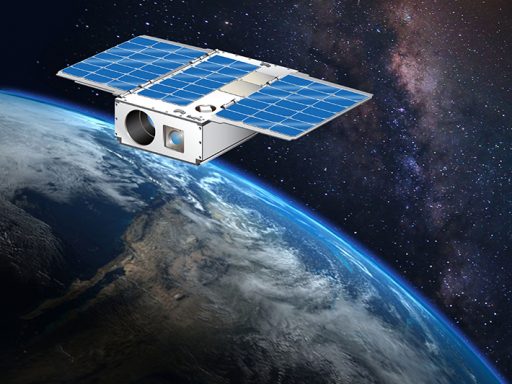
ASTERIA – Arcsecond Space Telescope Enabling Research in Astrophysics – is a potentially game-changing technology demonstration mission in the field of exoplanet astronomy – flying a 6U CubeSat outfitted with precise pointing systems, jitter reduction and an imaging detector to test whether this small-sized platform is suitable for the pointing requirements for searching exoplanets. The mission is conducted in a cooperation between the NASA Jet Propulsion Laboratory and MIT.
ASTERIA is a follow-on to the ExoPlanetSat project that proposed a 3U CubeSat outfitted with a closed loop control system on the satellite’s detector to compensate for platform jitter to achieve the pointing accuracy needed for photometric measurements looking for exoplanet transits across their host stars. The project evolved into ASTERIA with much improved photometric capabilities.
The project is funded via JPL’s Phaeton program for training early career employees. JPL is responsible for overall project management, system engineering, the attitude determination and control system, flight software, spacecraft integration & testing and mission operations while MIT handles the science aspect of the mission.
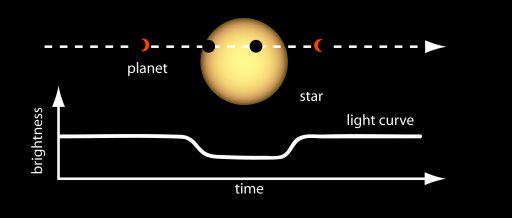
Transit photometry is the most commonly used method for detecting exoplanets and measuring their radii. If a planet crosses (transits) in front of its host star (as seen from the observer) it will cause the star’s visual brightness to drop. Depending on the relative sizes of the star and planet, this drop can be as large as 2% in observed brightness, but in most cases is only a few hundreds or a few thousands of a percent – requiring highly accurate instruments to make a conclusive detection.
Transit photometry is the favored method for exoplanet candidate detection as hundreds or thousands of stars can be observed simultaneously. However, the method has a number of drawbacks – the probability of a line-of-sight transit is rather low and it can not be guaranteed that any particular star is not a host to planets just because no transits are observed, even after an extended observation period.
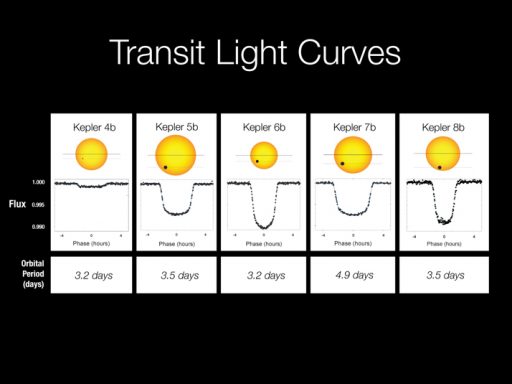
Another factor is a large number of false detections which requires exoplanet candidates identified through photometric measurements to be verified through another method like measuring the star’s radial velocity which will reveal whether planets are orbiting around it and influencing the star’s relative velocity to Earth by their gravitational fields.
Nevertheless, transit photometry and radial velocity measurements have proven to be a powerful combination as the former provides the planet’s radius by means of the fraction of light blocked by the planet and the latter provides the planet’s mass that arises from its gravitational influence on the host star. This in turn allows a planet’s density to be calculated from which some conclusions on its physical characteristics can be gleaned. Spectroscopic transit measurements can also reveal details on the composition of the exoplanet’s atmosphere and secondary eclipses (when the planet disappears behind its star) can reveal its temperature.
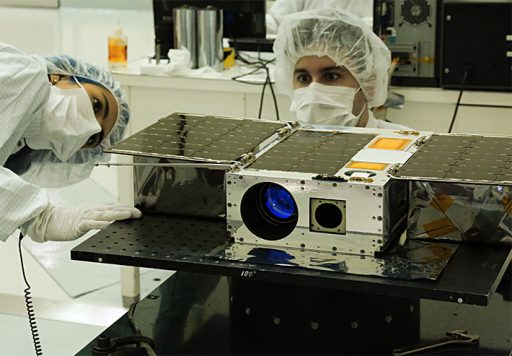
The miniaturization of a photometric detection system into a CubeSat form factor could enable a constellation of multiple orbiting observatories for a continuous study of the brightest sun-like stars which is not possible by conventional space observatories given their project cost. Having one or more CubeSats primed at a target star for extended duration could reveal long-transiting, Earth-like exoplanets.
However there are two critical requirements for accurate photometric measurements – a stable, jitter-free line of sight to the target star and a high photometric accuracy which requires highly stable thermal control for the detector device. Packaging systems into a CubeSat to satisfy these requirements is the major challenge to be overcome in order to realize a new way of searching for Earth-like exoplanets.
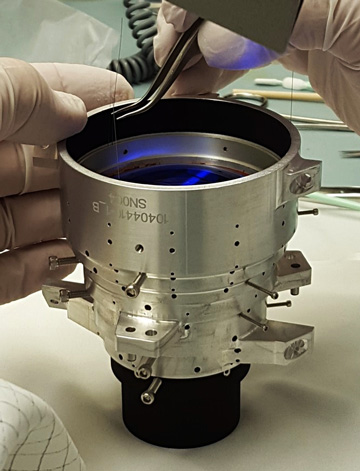
The 12-Kilogram, 10 x 20 x 30-centimeter ASTERIA satellite hosts a precise (8 arcsecond) attitude control system, a piezoelectric positioning stage for reducing spacecraft jitter on the detector and a highly stable focal plane temperature control (10 milli-Kelvin) that should allow for precise measurements of stellar brightness. Deployed into a Low Earth Orbit, ASTERIA will operate for up to one year as a proof-of-concept mission that could pave the way to a future fleet of small exoplanet hunters joining the search for Earth 2.0.
The ASTERIA payload combines two functions – the collection of science data in the form of photometric measurements that can be processed into lightcurves and the collection of fine attitude determination data for control of the jitter correction system. The payload suite includes an optics section, a dual-imager focal plane array realizing the two payload functions and a piezoelectric nano-positioning stage capable of moving the focal plane to zero-out the platform jitter.
Per the ExoPlanetSat baseline, the optics section was to use a f1.4/85 Zeiss lens with a 28.6-degree field of view and six elements, focusing an image 43 mm in diameter onto the focal plane. The focal plane array houses two active detector areas – one larger CMOS detector that fulfills the science function and a smaller CMOS sensor with smaller pixel sizes to act as a rapid-cadence star camera to provide attitude knowledge to the attitude control system. The science sensor operates at longer integration times and collects data on several pixel windows, one for the target star and several other bright stars for comparison plus dark areas of the sky for dark current correction.
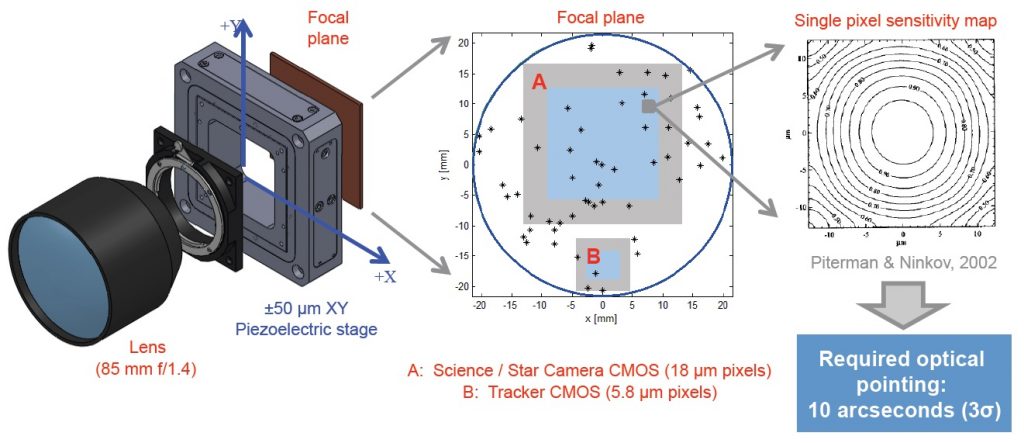
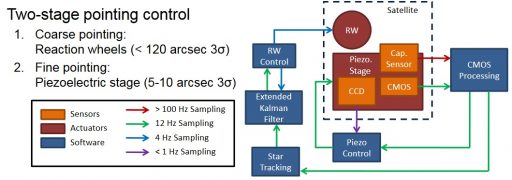
The satellite’s Attitude Determination and Control System comprises two major components – the coarse pointing system using a magnetometer and coarse sun sensors for initial de-tumble and sun acquisition as well as attitude sensing during the day portion of the orbit while a star tracker is in use as the primary attitude sensor to move the satellite toward the target star. Attitude actuation is provided by a set of commercial-off-the-shelf reaction wheels and three magnetic torque rods for wheel unloading, achieving an overall pointing accuracy better than 60 arcsecond.
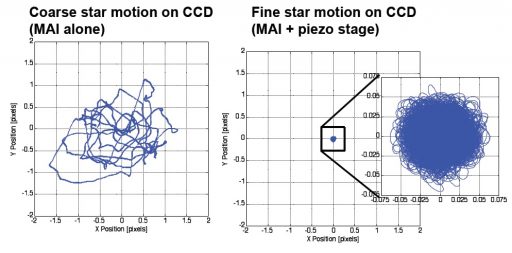
Once the target star field is in view, the satellite switches into fine-pointing mode where the primary attitude sensor is the smaller CMOS sensor on the focal plane, looking at a group of guide stars and feeding data into a closed loop system which actuates the two-axis piezoelectric stage to cancel out the spacecraft jitter by translating 100 micrometers along the X and Y directions to keep the guide stars on the same pixels of the fine star tracker and with that, keep the target star on the same fraction of a pixel on the science detector which has larger pixel sizes (~40arcsec/pixel). This avoids any issues arising from intrapixel and interpixel variations in quantum efficiency which would introduce an additional noise source (‘jitter noise’).
The requirement for shot-noise limited photometry (jitter-free) calls for a pointing accuracy of 10 arcsecond (3-sigma) and ASTERIA will satisfy this requirement with a baseline pointing accuracy of 8 arcseconds and expectations as high as 2.3 arcsec.
Science data delivered by the 1024 x 1024-pixel science camera comes in the form of postage stamp frames (sub-frame cut-outs including the target star, reference stars and dark space) which are time referenced. Once received on the ground, data will be put through an algorithm similar to that of the Kepler mission to remove systematic noise and obtain clean light curves for transit identification.
